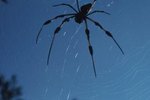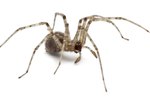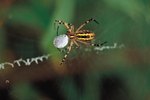Identifying wolf spiders can be challenging because they are commonly confused with the brown recluse, tarantula, huntsman and other spiders. With over 200 wolf spider species in the United States and Canada alone, identifying one takes careful observation of tiny features that set them apart from other spider types.
Wolf Spider Background
Wolf spiders are a family of spiders known as Lycosidae; the name comes from the Greek word “lycosa,” which means wolf. These spiders earned their family name because they hunt their prey instead of trapping it in a web. If you want to catch one to keep as a pet, bear in mind that wolf spiders hunt at night and usually live outside in burrows. When temperatures drop, wolf spiders will sometimes venture into human living areas and can be found near windows and in houseplants and garages.
Wolf Spider Eyes
The arrangement of a spider’s eyes can help you identify the species. Wolf spiders have eight eyes arranged in three rows. The top row visible from the front of the spider contains two larger eyes while the bottom row contains four smaller eyes. The spider also has two small eyes positioned on the top of its head. In comparison, the brown recluse spider and its relatives have six eyes arranged in a single row in pairs. The Huntsman spider has eight eyes, but they are arranged in two rows.
Behavioral Differences
Watching spider behavior can also help you differentiate between species. Wolf spiders do not weave webs. Instead, they move quickly in open areas, such as prairies or living room floors, chasing down their prey. In comparison, brown recluse spiders rarely come out in the open. They prefer to hide in dark places, such as under logs or in shoes.
Appearance Differences
The wolf spider has short legs for a spider, particularly compared to the huntsman spider, whose legs can grow up to 2 inches long. The brown recluse has a violin shape on its back that wolf spiders do not have. In fact, wolf spiders tend to be less interesting in their coloration and patterns than other spiders because they use camouflage for hunting and protection.
Because of their hairiness, wolf spiders are sometimes confused with tarantulas, but tarantulas are larger and heavier than wolf spiders.
Baby Care
Another noticeable difference between wolf spiders and other species is their care of eggs and spiderlings. Female wolf spiders attach their egg sacs to their spinnerets and carry the sac around until the babies begin hatching. At that point, the babies cover their mother's back and stay with her for several weeks eating the remains of the egg sac until they go off on their own. No other spider displays this type of maternal care for spiderlings.
References
Writer Bio
Amy Jorgensen has ghostwritten more than 100 articles and books on raising and training animals. She is also an amateur dog trainer. She has also written more than 200 blog posts, articles, and ebooks on wedding and party planning on behalf of professionals in the field.





